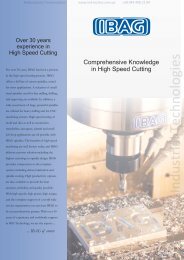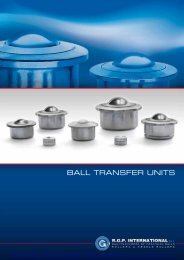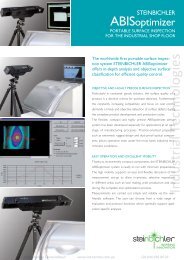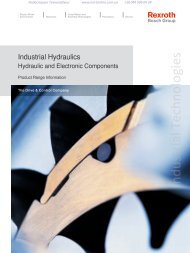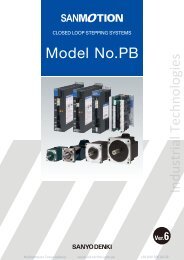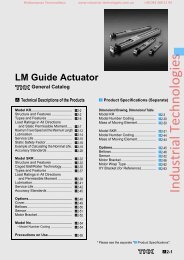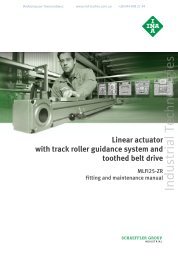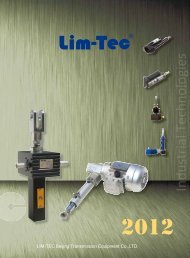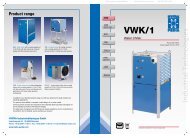Positioning System HIWIN - Industrial Technologies
Positioning System HIWIN - Industrial Technologies
Positioning System HIWIN - Industrial Technologies
- No tags were found...
You also want an ePaper? Increase the reach of your titles
YUMPU automatically turns print PDFs into web optimized ePapers that Google loves.
Индастриал Технолоджис www.ind-techno.com.ua +38 044 498 21 94<strong>Positioning</strong> <strong>System</strong>sCustomized <strong>Positioning</strong> <strong>System</strong>s1.1 GlossaryResolutionThis is the smallest stroke that can be detected by the distance measuringsystem in use. The achievable > increment is usually higher than the resolutiondue to additional factors.AccelerationThis is the speed change per time unit, i.e. acceleration = speed / time or a = v / t.Acceleration timeThis is defined as the time that a drive requires to reach maximum speedfrom standstill.Continuous torque, continuous force(also see Section 1.3, F c )A motor can produce continuous torque or nominal torque (with rotationalmovements) and continuous force or nominal force (with linear movements)in continuous operation (duty cycle = 100 %).Continuous current I c(also see Section 1.3, I c )This is the current supplied over a longer period; the maximum permittedcontinuous current per winding is referred to as the nominal current.The continuous current is characterized by the fact that the dissipationpower only results in motor warming of approximately 90 °C above ambienttemperature.TorqueThis is the dimension which causes a rotation movement in a body and consequentlya vectorial dimension, which can be expressed in the following cross product:M = r x F 1The torque is expressed physically in the unit Nm = kgm²/s².FlatnessThis is a measure for the vertical straightness of a movement on the X axis.A deviation from the absolute levelness is a shift on the Z axis when movingon the X axis.Guide deviationThis is the linear deviation from the stroke axis. It is dependent on straightness(thus the accuracy at the level of the table) and levelness (the accuracy externalto the level of the table).Back EMF constant(also see Chapter 1.3, K u )This is the relation between the back EMF voltage (rms) and the motor rotational speedor speed (rpm or m/s). Back EMF is the electromagnetic force that is created duringthe movement of windings in the magnetic field of permanent magnets, e.g.in a servo motor.Accuracy (Absolute accuracy)This, or the actual inaccuracy, corresponds to the deviation between a targeted positionand the actual position. The accuracy along an axis is defined as the differencebetween the actual and target positions after all other linear deviations that can beeliminated have been excluded. Such systematic and linear deviations are the result,for example, of cosine errors, angle deviations, shaft pitch errors, thermal expansionetc. Accuracy is calculated for all relevant target positions of an application using tothe following formula:Maximum of all sums of systematic target-actual deviations + 2 sigma(standard deviation). Accuracy must not be confused with > repeatability.StraightnessThis is a measure for the horizontal straightness of a movement on the X axis. A deviationfrom the absolute straightness is a shift on the Y axis when moving on the X axis.Force, torqueForce (in linear movements) or torque (in rotational movements) is givenfor defined conditions, e.g. as continuous force or torque at:25 °C ambient temperature110 °C winding temperature100 % operating time for linear motors and torque motors50 % operating time for rotary tablesor as peak force or peak torque.<strong>Industrial</strong> <strong>Technologies</strong>EccentricityThis is the deviation of the center point of rotation of rotary tables from its positionduring rotation. It is created by centering and bearing tolerances.2



